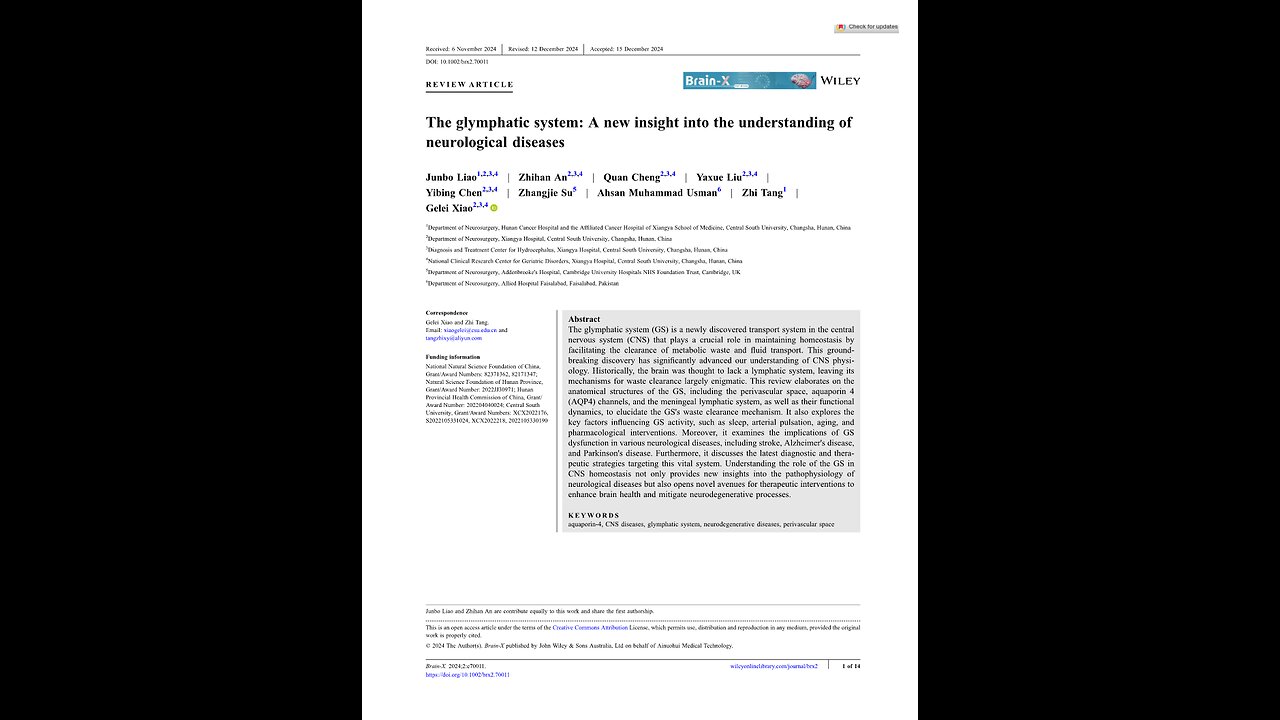Premium Only Content

The glymphatic system. 2024. A Puke(TM) Audiopaper
Index of Other Science Articles:
https://rumble.com/v3t4yzj-index-of-science.-music-by-dan-vasc.html
The glymphatic system: A new insight into the understanding of neurological diseases.
December 2024.
Junbvo Li, and others from:
Department of Neurosurgery, Hunan Cancer Hospital and the Affiliated Cancer Hospital of Xiangya School of Medicine, Central South University, Changsha, Hunan, China,
And other areas of the world.
https:--doi.org-10.1002-brx2.70011
Abstract.
The glymphatic system (GS) is a newly discovered transport system in the central nervous system (CNS) that plays a crucial role in maintaining homeostasis by facilitating the clearance of metabolic waste and fluid transport. This ground breaking discovery has significantly advanced our understanding of CNS physiology. Historically, the brain was thought to lack a lymphatic system, leaving its mechanisms for waste clearance largely enigmatic. This review elaborates on the anatomical structures of the GS, including the perivascular space, aquaporin 4 (AQP4) channels, and the meningeal lymphatic system, as well as their functional dynamics, to elucidate the GS's waste clearance mechanism. It also explores the key factors influencing GS activity, such as sleep, arterial pulsation, aging, and pharmacological interventions. Moreover, it examines the implications of GS dysfunction in various neurological diseases, including stroke, Alzheimer's disease, and Parkinson's disease. Furthermore, it discusses the latest diagnostic and therapeutic strategies targeting this vital system. Understanding the role of the GS in CNS homeostasis not only provides new insights into the pathophysiology of neurological diseases but also opens novel avenues for therapeutic interventions to enhance brain health and mitigate neurodegenerative processes.
KEYWORDS:
aquaporin-4, CNS diseases, glymphatic system, neurodegenerative diseases, perivascular space.
Key points.
What is known about this topic?
One. The GS has recently been identified as crucial for maintaining CNS homeostasis. Despite its significance, the mechanisms regulating its function and relationship with neurological diseases have not been fully elucidated. Current understanding highlights the roles of arterial pulsation, sleep, aging, and pharmacological agents in modulating glymphatic system activity. Dysfunctions in this system are increasingly implicated in the pathogenesis of various neurodegenerative diseases.
What does this study add?
Two. This review comprehensively analyzes the glymphatic system's structure, function, and influencing factors. It also explores emerging diagnostic and therapeutic strategies to treat CNS diseases by enhancing the activity of GS. By linking its dysfunction with specific neurological diseases, this review underscores the potential of targeting the GS therapeutically. The insights presented here offer a new perspective on managing CNS diseases.
One. INTRODUCTION.
The brain is the highest center of the human nervous system, dominating various physiological activities and responses of the human body. It has a high metabolic rate and is sensitive to changes in the tissue microenvironment homeostasis. In the peripheral tissues, soluble material, metabolic waste, and fluid from the interstitial space are returned to the systemic circulation through the lymphatic system. While the brain is characterized by a high metabolic rate, it completely lacks conventional lymphatic tissue from the traditional perspective. Until 2012, Iliff et al found that tracer could enter the brain parenchyma along the perivascular space (PVS) after intracisternal injection in mice. This discovery proved for the first time that a structure with a similar function to the lymphatic system exists in the CNS of mice, performing substance transport and metabolic waste clearance functions. Based on this research, the glymphatic system (GS) was proposed, Figure 1A.
Many studies on GS have been conducted in recent years. How to understand and leverage this substance transport system to treat CNS diseases clinically has become the focus of current research. In this review, we introduce GS structure and function, discuss factors influencing the GS and its relationship with some common and important neurological diseases, and summarize updated CNS disease diagnosis and treatment progress from the GS perspective.
Two. GS STRUCTURE AND FUNCTION.
2 point one. perivascular space.
The structure of the PVS can be described as a hollow cylinder. The cavity of the cylinder is the blood vessel, the inner circle of the cylinder is the endothelial cells of the blood vessel, smooth muscle cells and pericytes, which coincides with the structure of the blood-brain barrier (BBB), and the outer circle of the cylinder is the barrier surrounded by astrocytic end-feet, Figure 1B. The PVSs are usually identified in specific brain regions: the basal ganglia immediately superior to the basal perforating substance, where they are often connected to the cisternal cerebrospinal fluid (CSF), the hippocampus, the midbrain, pons, and so on.
FIGURE 1:
(A) Schematic of the structure of the GS.
(B) Schematic of the cross-section of the PVS and its surrounding structures.
(C) Schematic of the distribution of polarized or depolarized AQP4 on astrocyte end-feet.
(D) Schematic of the meningeal lymphatic system.
Robin et al proposed that the PVS is connected to the perineural space, which is now acknowledged as the meningeal lymphatic drainage channel. The PVS helps maintain brain health and normal GS function, and PVS dysfunction, such as abnormal enlargement of its diameter, has been associated with various neurological diseases.
Driven by arterial pulsation, respiration, and the CSF pressure gradient, part of the CSF enters the PVS of the cerebral parenchymal arteries, where it comes into contact with the outer astrocytes of the PVS, which mediate the import of CSF through the polarized aquaporin 4 (AQP4) channel on the astrocytic end-feet. During this phase, CSF flows into the brain parenchyma to fuse with the interstitial fluid (ISF), and the CSF-ISF converges into a “bulk flow” with metabolic waste and neurotoxic proteins in it, flowing to the PVS next to the vein and downstream meningeal lymphatic system, and finally participating in extracranial lymph circulation.
2 point 2. AQP4.
AQP4 is the main aquaporin in mammals and is abundantly expressed in astrocytes and ependymal cells. The outer border of the perivascular space is composed of astrocytic end-feet, whose abundant AQP4 enables the water in the CSF within the perivascular space to move into the ISF, allowing the transport of small molecules and ions, Figure 1C. At the same time, the gaps between the astrocytic end-feet allow macromolecular compounds to pass through. Abundant research has found that the lack of AQP4 or incorrect AQP4 location impedes fluid movement in the glymphatic system. A cross-sectional observational study in Australia showed that genetic variation in AQP4 modifies the association between sleep and amyloid Beta (A Beta) burden in the brain. Related studies have reported that the polarization of AQP4 in the PVS is important for both substance influx and efflux in the GS, and the absence of AQP4 on astrocytic end-feet significantly affects the clearance of extracellular solutes in the brain parenchyma. Therefore, interfering with the polarized distribution of AQP4 on the astrocytic endfeet can influence GS function.
2 point 3. Meningeal lymphatic system.
After the glymphatic system was proposed, where the so-called “bulk flow” flows to and what its destination is were hotly debated, with these questions challenging our understanding of the GS.
The subsequently discovered meningeal lymphatic system represents a channel system that removes CSF-ISF “bulk flow” to the cervical lymphatic circulation, Figure 1D, answering these questions, with the meningeal lymphatic vessel (MLV) as its main component, proving the existence of a lymphatic system in the brain. Immunostaining revealed that the MLV is specifically located around the superior sagittal sinus and left and right transverse sinuses, which express traditional lymphatic antigens such as lymphatic vessel endothelial hyaluronan receptor 1 (LYVE1) and podoplanin, PDPN. MLVs are primarily composed of lymphatic endothelial cells, and their molecular characteristics are similar to those of peripheral lymphatic vessels, which can be classified into capillary and collecting lymphatic vessels based on the presence or absence of lymphatic valves and smooth muscle cells. CSF is produced by the ventricular choroid plexus, passes through the perforating arterioles of the PVS to exchange substances with the interstation of the brain, and is finally discharged by the arachnoid granules and MLV’s.
The meningeal lymphatic system has emerged as a new player in the flow of CSF. Research has shown that basal MLVs are a major pathway for the uptake and drainage of CSF macromolecules. Chronic damage to the meningeal lymphatics reduces the drainage of CSF contents, leading to a reduction in the renewal of CSF-ISF macromolecules through the peripheral lymphatic tissue, which may cause functional changes in astrocytes, pericytes, smooth muscle cells, and endothelial cells, which together trigger neurodegeneration.
In addition, this transport system can transport all kinds of metabolic wastes and toxic substances in the brain, such as tau protein and metabolic lactic acid. The substance transport function of the GS plays an important role in the pathological process of neurodegenerative diseases, and it is promising as a target for future clinical treatment, which will be described in detail in the following section. The structure and function of the GS have still not been thoroughly investigated, and the nasopharyngeal lymphatic plexus and recently discovered subarachnoid lymphatic-like membrane enrich our understanding of the GS's structure.
Uncovering the structure of the entire GS or CSF circulation system warrants more attention in future studies.
Three. FACTORS AFFECTING GS FUNCTION.
After understanding the important role of the GS in substance transport in the CNS, studying factors interfering with the physiological glymphatic system function is vital for preventing and treating various neurological diseases, such as Alzheimer's disease (AD). Sleep, driving force, aging, and drugs have been identified as the main factors affecting GS function, which we will discuss in detail in the following sections.
3 point one. Sleep.
Sleep and wakefulness are two opposite states of consciousness. Studies have found that the amount of CSF flowing into the PVS of mice and humans and the “bulk flow” in the brain parenchyma is higher in the former than in the latter state, meaning that the removal of metabolic waste accumulated in the brain parenchyma during the day is often completed by the GS at night during sleep.
In mice, the brain's interstitial space was observed to enlarge during natural sleep, facilitating the convection of fluid and the transport of substances by the GS. The volume of the CSF is also increased, and the driving force is strengthened during sleep. One study used a mouse sleep deprivation model to determine the relationship between sleep and the GS. It was found that the rate of CSF flowing into the brain parenchyma was significantly slower in sleep-deprived mice than in mice with normal sleep, Figure 2A. It has also been reported that sleep deprivation increases the accumulation of toxic proteins in the brain parenchyma by affecting the GS substance clearance function during sleep, adversely affecting the brain, such as increased tau protein and A Beta accumulation in the brain.
As research advanced, Himali et al found that the GS waste removal function mainly occurs in slow-wave sleep. Sleep position is also closely related to the efficiency of the GS, Figure 2A. In rats, the brain tracer clearance rate was greater in the lateral position than in the supine and prone positions. The current hypothesis for this phenomenon is that the outflow resistance of the cerebral vein is the smallest in the lateral position, which is conducive to brain fluid movement. However, too few volunteers are included in relevant research, and larger samples are needed to analyze its mechanism further.
In summary, we believe there is a strong relationship between an abnormal sleep state and some neurodegenerative diseases, with the GS at their intersection. It is meaningful and promising to optimize the treatment of sleep quality in the future to improve GS function and produce curative effects in CNS diseases.
3 point 2. Driving force.
Factors influencing the force of CSF entering the PVS are arterial pulsation, respiration, and the CSF pressure gradient, and any abnormality in these factors will contribute to glymphatic system dysfunction. Among them, arterial pulsation may have the greatest effect and has been most extensively investigated.
One year after Iliff et al proposed the concept of the glymphatic system, they designed a comparative experiment to verify the driving role of cerebral artery pulsation in CSF entering PVS in which unilateral internal carotid artery ligation and dobutamine were used to intervene in the carotid pulsation of mice. By observing the CSF-ISF exchange process through fluorescence imaging, they found that cerebral artery pulsation is the key driving force for CSF entering the PVS, Figure 2B. Ringstad et al evaluated the functional level of the GS using magnetic resonance imaging (MRI) after intrathecal administration of CSF tracer in humans. Their results showed that the tracer propagated along the pial artery before the function of lymphatic vessels close to brain tissue was enhanced. This finding verified the conclusion of Iliff et al. After understanding that arterial pulsation drives CSF entering the PVS and then converging with ISF, relevant studies have focused on the qualitative dimension of this flow. In 2018, Mestre et al used the particle tracking method to quantify the CSF flow rate, providing a new evaluation index for future research. Their experiment also highlighted that patients with hypertension tend to have worse GS function because their backflow is increased and the net flow in the PVS is decreased. Soon after, this theory was also proved reliable in animal models.
FIGURE 2. Factors affecting GS function, including (A) sleep, (B) driving force, (C) aging, and (D) drugs.
One study adopted dynamic enhanced MRI to track the inflow and outflow rates of lymphatic vessels in a rat hypertensive model. Its results showed that hypertension impaired the normal physiological GS function. Limiting the arterial pulsation process and compliance impedes the GS transport process via various pathological processes, such as atherosclerosis, perivascular alterations, experimental hypercapnia, and chronic unpredictable mild stress. Therefore, drugs that promote blood vessels in the brain are being tested to see if they can enhance GS function to treat related diseases. Presently, L-3-n butylphthalide has been shown to enhance blood vessel pulsation in the brain to promote the perivascular drainage of A Beta in an animal model of AD, accompanied by optimized AQP4 localization, Figure 2B.
3 point 3. Aging.
One study using non-invasive MRI to calculate the diffusion tensor image analysis along the perivascular space (DTI ALPS) index to quantify the strength of glymphatic system function found that it was reduced in older adults, which may help explain why they are prone to accumulating neurotoxic proteins and are susceptible to neurodegenerative diseases, Figure 2C. Low glymphatic system function in older adults can be attributed to decreasing CSF-ISF exchange with age, which is associated with decreased CSF secretion and decreased arterial pulsation. AQP4 depolarization also plays an integral role in the degradation of GS function.
These structural abnormalities lead to GS dysfunction, which decreases the brain parenchymal A Beta clearance rate and thereby causes age-related cognitive decline.
The impact of aging on the MLVs of the meninges also affects the glymphatic clearance of toxic substances. Recent studies have reported that enhancing the GS can reduce A Beta in the brain, delaying brain aging. Reducing the deposition of A Beta and tau proteins improves memory and increases A Beta internalization in microglia, suggesting that unobstructed GS function may significantly contribute to preserving memory function as we age. Studies have reported that impaired GS function can exacerbate neuro inflammation by reducing the clearance of cytokines in the brain, exacerbating memory decline and cognitive deficits in a more direct and specific manner, which may be the mechanism of symptom progression with age.
3 point 4. Drugs.
It has been observed in mouse models that the brain's interstitial space enlarges under anesthesia, facilitating the convection of CSF and ISF and the drainage of substances. However, a recent animal study indicated that general anesthesia do not support this conclusion, suggesting that it instead hinders glymphatic system function. While different anesthetics were found to cause different CSF production rates, an important factor affecting the clearance efficiency of the glymphatic system, the final results showed no significant relationship between the CSF production rate and GS transport efficiency. This finding suggests that different anesthetic mechanisms may not only affect the CSF production rate but also undetected factors that directly or indirectly interfere with the substance transport process of the GS.
As drugs, omega-3 and alcohol have been found to affect GS function, Figure 2D. Omega-3 can enhance the substance transport function of the GS by maintaining astrocyte function, which has been experimentally confirmed in GS-damaged and traumatic brain injury models. In contrast, alcohol has been found to play a dual role in regulating the GS. A small amount of alcohol enhances GS function, while a high amount of alcohol inhibits the transport efficiency of the GS. This phenomenon may be because alcohol can relax blood vessels and induce the cellular reactivity between the vascular endothelium and smooth muscle to enhance the clearance of metabolic waste. Increased Beta-endorphin release and decreased cerebral vascular compliance may explain why GS activity decreased after acute alcohol administration in mice.
However, the anesthetic effect of alcohol in the experiment cannot be ignored because physiological GS function is altered under anesthesia. In addition, acetazolamide and adrenergic receptor antagonists inhibit AQP4 production and norepinephrine transmission in the CNS, regulating GS activity respectively.
Four. THE RELATIONSHIP BETWEEN THE GS AND NEUROLOGICAL DISEASES.
4 point 1. Stroke.
Stroke is the blockage and rupture of blood vessels in the brain, which damages the CNS structure and function. Data show that stroke is an important factor in the rates of disability, dementia, and death worldwide. According to whether there is bleeding, it can be divided into hemorrhagic stroke and ischemic stroke. The glymphatic system plays an important role in stroke pathophysiology, including brain edema, BBB disruption, immune cell infiltration, neuro inflammation, and neuronal apoptosis. Presently, many studies are examining the effect of stroke on glymphatic system function and their interaction. Summarizing and reviewing their findings is of great significance for treating stroke in the future.
Subarachnoid hemorrhage (SAH) causes blood components such as fibrin to block the PVS, reducing the inflow of CSF, weakening the CSF-ISF circulation, and decreasing the ability to clear abnormal proteins, Figure 3A. The inflow of GS was found to be significantly reduced in the SAH model, while intraventricular injection of tissue plasminogen activator (t-PA) could improve GS function after clearing the accumulated blood components in the PVS. GS damage after SAH is often accompanied by an inflammatory reaction and apoptosis, exacerbating the damage to neural function.
FIGURE 3. Relationship between the GS and common neurological diseases, including (A) stroke, (B) CSF homeostasis diseases, and (C) neurodegenerative diseases.
The cerebral lymphatic circulation is damaged after SAH, and CD3 plus, CD4 plus and CD8 plus lymphocytes accumulate abnormally in the brain parenchyma, causing pathological changes such as glial cell activation and neuro inflammation, which indicates that the dysfunction of glymphatic inflow after SAH injury is closely related to the neuropathological damage, Figure 3A. The MLV can extravasate erythrocytes from the CSF into cervical lymph nodes after SAH, indicating that regulating this draining may provide a therapeutic approach to alleviate SAH severity, Figure 3A. One study reported that nimodipine reduced early brain damage after SAH by protecting the glymphatic system, suggesting that drug intervention to protect glymphatic system function may be a potential method for treating SAH.
Intracerebral hemorrhage (ICH) is another subtype of hemorrhagic stroke, and research on the GS and ICH is currently limited. Studies have reported that an enlarged PVS (EPVS) is associated with an increased risk and recurrence of ICH, Figure 3A, but its specific mechanism is still unclear, and further research is needed. Related studies have reported that MLV’s promote hematoma clearance after ICH, and their ablation and blockage impeded this process, Figure 3A. The GS can participate in eliminating intracerebral metabolite clearance disorders caused by ICH. These studies suggest the potential role of the GS in the ICH prognosis. Ischemic stroke is an acute cerebrovascular disease with a high incidence and disability rate. In mice, enhanced MRI showed impaired glymphatic perfusion in the acute phase of ischemic stroke, Figure 3A. Embolic ischemic stroke has been shown to temporarily inhibit glymphatic flow, Figure 3A, which may exacerbate tissue damage through the accumulation of metabolic waste and injury debris. In the late stage of ischemic stroke, AQP4 has a protective function in reducing brain edema by regulating water delivery from the ISF to the PVS, Figure 3A. The GS is beneficial for recovering from ischemic stroke, can alleviate post-stroke dementia, and can improve the clearance of brain metabolic waste such as tau protein, Figure 3A.
4 point 2. CSF homeostasis diseases.
Cerebral edema is a common complication after stroke.
Generally, cerebral edema is divided into cytotoxic, vasogenic, and interstitial physiological types. Clinically, the first two are mainly caused by stroke. Cytotoxic cerebral edema results from an abnormal metabolic state induced by insufficient energy supply in neurons due to hypoxia and ischemia, hindering the transport of intracellular and extra cellular substances, such as Na plus, K plus, and Ca2 plus.
With further hypoxia-ischemia, BBB begins to be damaged, leading to angiogenic cerebral edema. The traditional view is that excess fluid generated by cerebral edema is cleared through the cerebral vascular endothelium. However, due to hydrostatic pressure and the osmotic gradient, BBB opening after stroke is more conducive to fluid inflow into the brain parenchyma than outflow.
The glymphatic system provides a new direction for the mechanism of cerebral edema occurrence and development. glymphatic system-mediated CSF influx may contribute to the accumulation of a large amount of fluid in the early stage of cerebral edema, Figure 3B. This theory can explain the contradiction between BBB destruction and recovery and the development time of cerebral edema. One study indicated that the recovery of GS function may not only promote the resolution of cerebral edema but also improve the self-regulation function of the brain, Figure 3B. In addition, the redistribution of AQP4 is consistent with the regression time of cerebral edema, showing that the GS is involved in cerebral edema development and regression. Notably, AQP4 has been shown to play a complex bimodal role in cerebral edema after ischemic stroke, Figure 3B. Because the water flow mediated by AQP4 is bidirectional, AQP4 may cause cytotoxic edema by promoting water entry into astrocytes in the early stages of ischemic stroke. In contrast, due to BBB disruption, AQP4 may alleviate secondary vascular cerebral edema in the late stages of ischemic stroke by mediating excessive water transport from the interstitial space to the GS. Therefore, the subcellular localization of AQP4 and its role in affecting GS function and brain edema require further research.
Hydrocephalus is caused by the inappropriate production, circulation, and absorption of CSF due to impaired fluid mechanics of intracranial fluids between brain, and blood compartments. Its abnormal cranial pressure and damaged microenvironment will contribute to CNS disruption. Studies have reported that hydrocephalus is related to GS obstruction, such as EPVS and AQP4 loss, and that MLVs are involved in the progression of brain injury and secondary hydrocephalus after intraventricular hemorrhage.
Here, we explore the role of the GS in normal pressure hydrocephalus (NPH) and idiopathic NPH, iNPH. Bradley has a prospective attitude toward NPH; he tends to believe that NPH is secondary to injury. Patients with NPH tend to have a larger intracranial volume, indicating that they experienced mild hydrocephalus as infants. At that time, CSF flows through the ependyma and is then discharged through AQP4 on the venous side of the PVS, working as a type of compensatory mechanism, Figure 3B. In iNPH, CSF production decreases, and the resistance to CSF absorption increases, leading to slower CSF circulation and reduced macromolecule clearance. One study found that the CSF contents of the 42-residue A Beta isoform, total tau, and phosphorylated tau were significantly lower in patients with iNPH than in those with general AD. This observation may be due to the dilution effect of excess CSF in the patients with iNPH, which may be a biomarker warranting further study.
Determining and understanding the role of the GS in hydrocephalus pathogenesis may open up a new way to non-surgically treat hydrocephalus in the future.
4 point 3. Neurodegenerative diseases.
AD is a degenerative disease of the CNS characterized by progressive cognitive function and behavioral impairment, which is becoming an increasingly serious issue due to its massive impact on individuals and society, Figure 3C. Since a typical feature of AD is the accumulation of extracellular deposits of A Beta, the constant removal of A Beta from the aging brain is critical to reducing the accumulation of A Beta neurotoxins. A Beta accumulation in the brain may be facilitated by reduced glymphatic system function with age. Reduced glymphatic flow into the aging brain may limit the distribution of CSF to the brain and reduce intermittent CSF convection and thus the removal of A Beta and other neurotoxic wastes, Figure 3C.
In the aging brain, the dislocation of AQP4 from the end feet to the cytosol of astrocytes is associated with glymphatic failure. It has been shown that glymphatic transport is inhibited in AD model mice, aged APP-PS1 mice with significant A Beta deposition, whereas glymphatic clearance is significantly reduced before significant A Beta deposition occurs in young APP-PS1 mice. Therefore, decreased glymphatic transport may be an early biomarker of AD, and therapies to restore normal glymphatic transport and intracerebral waste clearance may become a new preventive or therapeutic approach for AD.
Parkinson's disease (PD) is a neurodegenerative motor disorder characterized by the loss of dopaminergic neurons in the substantia nigra compacta and intracellular accumulation of misfolded alpha-synuclein (Alpha-syn) protein. GS drainage is considered effective in clearing Alpha-syn and plays a role in PD progression, Figure 3C. In the brains of patients with PD, Alpha-syn is negatively correlated with AQP4 expression, indicating a relationship between GS dysfunction and protein accumulation.
Presently, studies have used non-invasive MRI to explore the effects of GS interventions on the development and progression of neurodegenerative diseases in clinical practice, which may be a new direction for their treatment in the future, Figure 3C.
Five. DIAGNOSTIC AND THERAPEUTIC STRATEGIES FOR CNS DISEASES FROM GS PERSPECTIVE.
The previous section reviewed the relationship between the glymphatic system and various CNS diseases. glymphatic system function is generally impaired in various CNS diseases, suggesting that strategies based on repairing the damaged GS or enhancing GS function have great clinical significance and application prospects.
In recent years, as the GS components have been explored one by one, many attempts at GS-based therapeutic solutions for CNS diseases have emerged, and we will summarize these recent advances from both diagnostic and therapeutic perspectives.
5 point 1. Glymphatic system-based diagnostic biomarkers for CNS diseases.
The PVS is the primary site of CSF inflow into the glymphatic system. The PVS is normally around 0.3 millimeters in diameter, which is challenging to identify and observe with the naked eye using conventional imaging. A PVS with a diameter of greater than 0.66 millimeters can be directly observed using 3.0 Tesla MRI and is called an EPVS. This phenomenon is often found in older adults and patients with cerebral small-vessel diseases, such as cerebral amyloid angiopathy. It is one of the disease markers used to diagnose cerebral small-vessel diseases, Figure 4A1. Structural enlargement of the PVS as a part of the GS is not limited to cerebral small-vessel diseases, it has also shown great value in diagnosing other diseases.
Numerous studies have shown that EPVS is closely associated with various neurodegenerative and neuro inflammatory diseases. A Beta deposition is critical in AD pathogenesis, where damage to the GS, decreasing its function, contributes to the abnormal accumulation of denatured A Beta. Age-related changes in the vascular wall and damage to the BBB have been shown to lead to the accumulation of blood-borne substances in the PVS, resulting in an EPVS. This structural abnormality ultimately leads to impaired GS function, resulting in abnormal A Beta accumulation. Many clinical studies have found that MRI findings in such patients with Alzheimer's disease tend to have more EPVS than normal subjects, demonstrating its great potential as an imaging marker for diagnosing AD, Figure 4A1. Similarly, EPVS’s have been found at high frequency in the centrum semiovale, basal ganglia, and midbrain of patients with PD, with a positive correlation between the number of EPVSs in the midbrain and postural instability symptoms.
FIGURE 4. Updated diagnostic and therapeutic approaches for CNS diseases from a GS perspective, including diagnostic biomarkers (A1) EPVS and (A2) DTI-ALPS and the therapeutic strategies (B1) voluntary exercise, (B2) 40 Hertz multisensory stimulation, (B3) lymphaticovenular anastomosis, and (B4) drug delivery via the meningeal lymphatic system.
Like in AD, where A Beta deposition continuously damages the glial vascular unit, resulting in a positive feedback pathological process of EPVS formation, increased deposition of misfolded Alpha-syn also results in impaired PVS in PD. Further evidence suggests that an impaired PVS further exacerbates PD symptoms due to the resulting reduced drainage of the glymphatic system, Figure 4A1. In neuro inflammatory diseases such as multiple sclerosis, the PVS is significantly enlarged in the exacerbation phase compared to the resting phase, suggesting that an EPVS may be one of the exacerbation imaging markers in multiple sclerosis, Figure 4A1.
In addition to using structural changes in the GS to diagnose and predict CNS diseases, current studies have also identified glymphatic system function as one of the important diagnostic indicators. DTI-ALPS, a non-invasive, contrast agent-free imaging technique, evaluates the difference in the diffusivity of water molecules in different orientations to calculate an DTI ALPS index reflecting GS function. A decrease in this index represents a decrease in the diffusivity of water molecules in the PVS, suggesting reduced GS function. A cohort study involving 50 patients with AD and healthy individuals showed that the DTI-ALPS index correlated negatively with A Beta and tau deposition on positron emission tomography images and positively with cognitive function scores, Figure 4A2. Many similar studies have reported the same result, suggesting that the DTI-ALPS index may be a valid predictor of cognitive function assessment and can also be used as an important indicator to assess CNS disease progression and treatment efficacy.
Regarding PD, one study found that the ALPS index was lower in patients with advanced PD than in healthy controls, Figure 4A2. Subsequent studies have noted a strong relationship between this index and disease severity and the type of motor symptoms in patients with PD, indicating its great potential to serve as a biomarker of motor symptoms in PD. Patients with iNPH, a disease widely speculated to result from GS impairment, were found to have significantly lower DTI-ALPS indices than healthy controls, with the ALPS indices significantly positively correlated with the corpus callosum angle, which could reflect disease severity to a certain extent, Figure 4A2. The DTI-ALPS indices and Mini-Mental State Examination scores of patients with iNPH increased significantly after lumboperitoneal shunt surgery, indicating that shunt surgery can reduce the impairment of GS function in patients with iNPH and improve their symptoms. Therefore, this study highlighted the feasibility of the DTI-ALPS index for diagnosing iNPH and monitoring treatment effects.
5 point 2. GS-based treatments for CNS diseases.
As the structure and physiological function of the GS and related influencing factors are gradually being clarified, new treatment strategies for CNS diseases that enhance GS function or protect the damaged GS have emerged in recent years. Since many have shown great feasibility and clinical significance, it can be foreseen that GS-based therapeutic solutions will mature in the near future and be implemented in clinical practice.
In AD pathogenesis, GS dysfunction leads to abnormal A Beta accumulation, which is one of the important links. It has become a hot research topic in the field of AD treatment through interventions to enhance GS function. As one of the non-invasive therapeutic strategies for AD, exercise therapy has attracted significant attention. Preclinical studies have shown that voluntary exercise can regulate the polarization of AQP4 and improve AQP4 expression in the PVS to promote A Beta clearance in cognitively deficient mice.
Many studies have demonstrated that exercise therapy can improve the heart rate, the perfusion flow, the cerebral pulse pressure, and the ISF flow in the brain, thereby affecting GS function, Figure 4B1. One of the current stars in non-invasively treating AD is 40 Hertz multisensory stimulation. While there has been previously controversy about its specific therapeutic mechanism, recent studies have revealed GS as the basis of the therapeutic effects of 40 Hertz multisensory stimulation in AD. The alternating stimulation increases the polarization of AQP4 on the end feet of astrocytes, inducing the expansion of the MLV’s and thus reinforcing GS function, Figure 4B2. Currently, treating Alzheimer's disease through microsurgical interventions is also promising.
Xie et al achieved the remodeling of lymphatic vessels in the brain through lymphatic vessel reconstruction techniques, such as lymphaticovenular anastomosis, with the treated patients showing significant improvements in behavior, cognitive function, and memory, Figure 4B3.
This novel surgical treatment is currently undergoing animal experiments and clinical studies to further explore the specific mechanisms of its therapeutic efficacy.
While dysfunction of the GS, as a substance transport system, is of concern for the accumulation of metabolic wastes and toxic substances, we should not overlook its potential as a gateway for central drug delivery. Surprisingly, one study found that subcutaneous injection of nano medicines near local lymph nodes in the neck was 44 times more efficient than traditional intravenous drug delivery.
By relying on the meningeal lymphatic system, this CNS drug delivery approach bypasses the obstruction of structures such as BBB, warranting consideration for delivering drugs to treat CNS diseases, Figure 4B4. A recent study delivering bionic nano complexes via the meningeal lymphatic system to treat PD in a mouse model found that MLV administration improved the delivery efficiency of curcumin into the brain by about 20 fold, significantly improving motor deficits and neuronal death. Developing novel and efficient CNS drug-delivery technologies based on the meningeal lymphatic system is a hot topic in drug delivery research and will be a major focus in future research.
AUTHOR CONTRIBUTIONS.
ACKNOWLEDGMENTS.
CONFLICT OF INTEREST STATEMENT.
The authors declare that they have no conflicts of interest.
DATA AVAILABILITY STATEMENT.
ETHICS STATEMENT.
ORCID.
One Hundred and Forty Five REFERENCES.
-
 LIVE
LIVE
Dr Disrespect
4 hours ago🔴LIVE - DR DISRESPECT - ARC RAIDERS - BLUEPRINTS OR DEATH
2,571 watching -
 1:10:26
1:10:26
Sean Unpaved
3 hours agoJalen Hurts & Eagles COLLAPSE In LOSS vs. Cowboys | UNPAVED
16.5K2 -
 2:00:25
2:00:25
Steven Crowder
6 hours agoNo Influencer Safe: New X Update Exposed A Major Psyop
422K260 -
 17:38
17:38
Professor Nez
3 hours agoTHIS will HAUNT Jasmine Crockett for Years...
14.9K20 -
 56:36
56:36
The Rubin Report
4 hours agoTense Moment at Trump-Mamdani Meeting That No One Predicted
46.7K73 -
 9:34
9:34
The White House
4 hours agoFirst Lady Melania Trump Welcomes the Official 2025 White House Christmas Tree
35.2K16 -
 LIVE
LIVE
LFA TV
17 hours agoLIVE & BREAKING NEWS! | MONDAY 11/24/25
1,759 watching -
 1:01:32
1:01:32
VINCE
6 hours agoNew Info Blows the Lid Off The Butler Assassination Attempt | Episode 175 - 11/24/25 VINCE
267K245 -
 1:46:29
1:46:29
The Mel K Show
4 hours agoMORNINGS WITH MEL K - A Time to Choose: The People Must Reclaim Power 11-24-25
32.2K13 -
 1:23:10
1:23:10
The Shannon Joy Show
4 hours agoMarjorie Taylor Greene DUMPS Trump, Defects To ‘America First’ Setting Up NEW Paradigm For 2028 Presidential Election
21.6K15